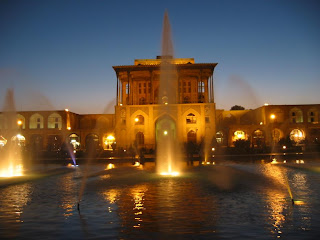 Isfahan or Esfahan (historically also rendered as Ispahan, Old Persian Aspadana, Middle Persian Spahan, Persian اصفهان) located about 340 km south of Tehran is Iran (Persia)'s third largest city. Isfahan has been designated by UNESCO as a world heritage city. It contains a wide variety of Islamic Architectural sites ranging from the 11th century to the 19thcentury. Literature on isfahan reveals that this city's"golden age" began in 1598,when shah abbas made it his capital and build several monuments thats stand superb even today.some of these 17th century monuments are the imam mosque,sheikhlotfollah mosque,chehel sotun palace,maiden-e-imam,ali ghapu palace & jam-abbasi mosque.(The photo shows alighapu palace)
Isfahan or Esfahan (historically also rendered as Ispahan, Old Persian Aspadana, Middle Persian Spahan, Persian اصفهان) located about 340 km south of Tehran is Iran (Persia)'s third largest city. Isfahan has been designated by UNESCO as a world heritage city. It contains a wide variety of Islamic Architectural sites ranging from the 11th century to the 19thcentury. Literature on isfahan reveals that this city's"golden age" began in 1598,when shah abbas made it his capital and build several monuments thats stand superb even today.some of these 17th century monuments are the imam mosque,sheikhlotfollah mosque,chehel sotun palace,maiden-e-imam,ali ghapu palace & jam-abbasi mosque.(The photo shows alighapu palace)Esfahan [Isfahan] is said to be the primary location of the Iranian nuclear weapons program. The Nuclear Technology/Research Center in Esfahan is Iran's largest nuclear research center, and is said to employ as many as 3,000 scientists. Iran signed an agreement France in 1975 to build a nuclear research center in Isfahan, to provide training for personnel to operate the Bushehr reactor, located at the University of Isfahan. As of 1977 Iran reportedly planned to have at least one reactor and a small French-built fuel reprocessing facility in Isfahan by 1980.
The University of Isfahan, with over 50 years of experience, is one of the leading higher educational institutes in Iran. The university embraces seven faculties with thirty departments as well as an evening school. The University of Isfahan has a unique location at the foot of the Kuh Sofeh (Sofeh mountain, 32°35'00"N 51°38'00"E) with an area of 4.5 million square meters. Over 1000 graduate students and 10,000 under-graduate students are trained in various fields of Science, Engineering, Human Science, Economics, Linguistics, Educational Science and Sport Science.
1 comment:
commenting in ur blog is very much complicated :D
Post a Comment